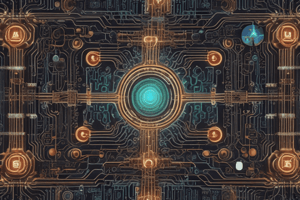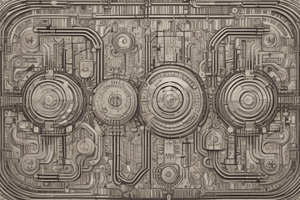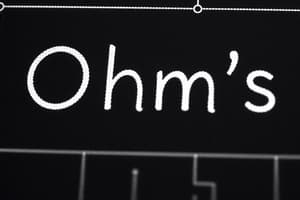Podcast
Questions and Answers
In a parallel circuit, what remains constant across all loops?
In a parallel circuit, what remains constant across all loops?
- Resistance
- Current
- Voltage (correct)
- Wattage
A closed switch creates an open circuit, preventing the flow of electricity.
A closed switch creates an open circuit, preventing the flow of electricity.
False (B)
According to Ohm's Law, what is the relationship between voltage, current, and resistance?
According to Ohm's Law, what is the relationship between voltage, current, and resistance?
Voltage equals current multiplied by resistance (V=IR)
According to Watt's Law, Wattage is the product of current and ______.
According to Watt's Law, Wattage is the product of current and ______.
Match each electrical unit with the corresponding quantity it measures.
Match each electrical unit with the corresponding quantity it measures.
What principle does electricity generation rely on, involving a rotating magnet?
What principle does electricity generation rely on, involving a rotating magnet?
In a series circuit, voltage remains constant across all components while current is shared.
In a series circuit, voltage remains constant across all components while current is shared.
What is the primary function of a diode in an electrical circuit?
What is the primary function of a diode in an electrical circuit?
In a cell, the ______ is where oxidation (removal of electrons) occurs.
In a cell, the ______ is where oxidation (removal of electrons) occurs.
What is the formula for calculating charge?
What is the formula for calculating charge?
Flashcards
Voltage (V)
Voltage (V)
Measures potential difference (electrical pressure).
Current (I)
Current (I)
Measures the flow of electric charge.
Resistance (Ω)
Resistance (Ω)
Measures opposition to current flow.
Wattage (W)
Wattage (W)
Signup and view all the flashcards
Charge (C)
Charge (C)
Signup and view all the flashcards
Ohm's Law
Ohm's Law
Signup and view all the flashcards
Watt's Law
Watt's Law
Signup and view all the flashcards
Coulomb's Law (Charge)
Coulomb's Law (Charge)
Signup and view all the flashcards
Faraday's Law of Induction
Faraday's Law of Induction
Signup and view all the flashcards
Static Electricity
Static Electricity
Signup and view all the flashcards
Study Notes
- Voltage is measured in Volts (V) and indicates potential difference or pressure.
- Current is measured in Amps (A) and indicates the flow of electric charge.
- Resistance is measured in Ohms (Ω) and indicates how well electrons pass through a material.
- Wattage is measured in Watts (W) and indicates power.
- Charge is measured in Coulombs (C).
Ohm's Law (Resistance)
- V = IR
- Voltage equals Current multiplied by Resistance.
- Example: A series circuit with a 12V battery connected to a 6Ω resistor has a 2A current.
Watt's Law (Power)
- W = IV
- Wattage equals Current multiplied by Voltage.
- Australian power supply is typically 230V AC at 50Hz.
Coulomb's Law (Charge)
- C = It
- Coulombs equal Amperage multiplied by time (in seconds).
Faraday's Law of Induction (Induced Voltage)
- V = -N(dΦ/dt)
- Induced voltage equals the negative number of loops multiplied by the change in magnetic flux over the change in time.
Currents
- Static electricity involves the movement of electrons between surfaces, causing temporary shocks.
- Example: Combing hair causes the comb to brush off electrons, making the hair positively charged.
- Sunlight can ionize metal lattices, creating free electrons.
- Current electricity involves the movement of electrons through a circuit.
Current Types
- In a series circuit, the current is constant, and voltage is shared across components.
- In a parallel circuit, the voltage is constant, and current is shared across loops.
- Electricity follows the path of least resistance.
- In a parallel circuit, if one path has half the resistance of another, it receives double the current because voltage is consistent.
Electromagnetism
- Electricity generation involves using water, steam, or another medium to turn a turbine/rotor, which rotates a magnet.
- The rapid rotation of the magnet creates a changing magnetic field, inducing AC current.
- This process creates a potential difference, causing electricity to flow.
Electrical Components
- Cell: Generates electrical current with a cathode and anode.
- Batteries: Utilize materials with potential electrical energy, such as lithium-ions
- Switches: Control the flow of electrical current.
- An open switch creates an open circuit, stopping current flow.
- A closed switch creates a closed circuit, allowing current flow.
- Diode: Conducts electricity in one direction with low resistance on one end and high resistance on the other.
- Cathodes are positive, where reduction (gain of electrons) occurs.
- Anodes are negative, where oxidation (removal of electrons) occurs.
- Globe: Emits light.
- Resistors: Reduce electric current.
- Capacitors: Store electricity in the form of charge.
- Fuse: Provides overcurrent protection.
Studying That Suits You
Use AI to generate personalized quizzes and flashcards to suit your learning preferences.




